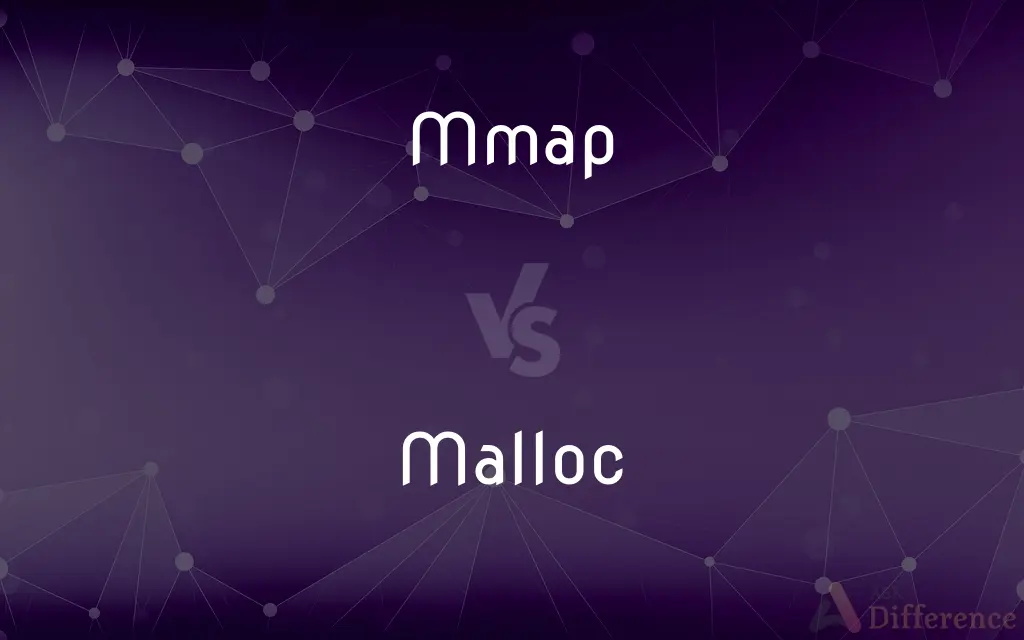Mmap vs. Malloc — What's the Difference?
By Tayyaba Rehman & Fiza Rafique — Updated on March 21, 2024
Mmap maps files or devices into memory for efficient file I/O, while malloc allocates memory on the heap for dynamic data storage.

Difference Between Mmap and Malloc
Table of Contents
ADVERTISEMENT
Key Differences
Mmap is primarily used for mapping files or devices into a process's memory space, facilitating efficient file I/O operations. This allows direct file access from memory, reducing the overhead of traditional file read/write systems. On the other hand, malloc is a standard memory allocation function in C programming, used to allocate a specified amount of memory on the heap. It is commonly used for dynamic memory allocation where the size of the memory needed isn't known at compile time.
Mmap provides the advantage of letting multiple processes share the same memory-mapped file or device, enabling inter-process communication and efficient file access. Whereas, memory allocated by malloc is private to the process that allocated it, and sharing it with other processes is more complex and typically involves using inter-process communication mechanisms.
The memory region allocated by mmap is automatically initialized to zero or the contents of the mapped file or device. This can be particularly useful when mapping files to memory, as it negates the need for explicit reading of the file. Malloc, in contrast, does not initialize the allocated memory, potentially leaving it filled with garbage values until it's explicitly initialized by the programmer.
Mmap can also offer performance benefits for large datasets by leveraging the virtual memory system's capabilities, such as lazy allocation and swapping. Malloc's performance is generally consistent and predictable but may not be as optimized for large-scale data handling as mmap.
One of the limitations of mmap is that it is closely tied to the underlying operating system's capabilities and might have system-specific restrictions, such as alignment or size limitations. Malloc is more portable and standardized across different C environments, making it a more versatile choice for memory allocation in cross-platform applications.
ADVERTISEMENT
Comparison Chart
Primary Use
Mapping files/devices into memory for efficient file I/O
Allocating memory on the heap for dynamic data storage
Memory Source
Direct access to file system or device memory
Heap memory
Initialization
Automatically initialized to zero or file/device contents
Uninitialized, may contain garbage values
Sharing
Facilitates sharing memory-mapped files between processes
Allocated memory is private to the process
Portability
System-specific, dependent on OS capabilities
Standardized and portable across different C environments
Compare with Definitions
Mmap
Can be more efficient for large-scale data handling due to OS-level optimizations.
Mmap can leverage virtual memory management features like lazy allocation.
Malloc
Allocated memory is not automatically initialized.
Memory obtained via malloc may contain random garbage values until explicitly initialized.
Mmap
Enables sharing of memory-mapped files between processes.
Two processes can communicate by writing and reading from a shared memory-mapped file.
Malloc
Allocates memory from the process's heap space.
Malloc increases the size of the heap when allocating new memory.
Mmap
Used to map files or devices into memory for efficient access.
Mmap is often used to map a large file for fast, random access.
Malloc
Memory allocated is private to the allocating process.
Sharing malloc-allocated memory between processes requires explicit mechanisms like IPC.
Mmap
May have alignment or size limitations based on the OS.
Some systems require mmap allocations to be page-aligned.
Malloc
Allocates memory on the heap for variable-sized data storage.
Malloc is used to allocate an array whose size is determined at runtime.
Mmap
Memory-mapped areas are automatically initialized.
Memory-mapped files are initialized with the file's contents on mapping.
Malloc
Standardized across different C environments, making it widely usable.
Malloc behaves consistently across various platforms and compilers.
Mmap
In computing, mmap(2) is a POSIX-compliant Unix system call that maps files or devices into memory. It is a method of memory-mapped file I/O. It implements demand paging because file contents are not read from disk directly and initially do not use physical RAM at all.
Malloc
(computing) A subroutine in the C programming language's standard library for performing dynamic memory allocation.
Malloc
(computing) To allocate memory using the C programming language malloc subroutine.
Common Curiosities
How does malloc work?
Malloc allocates a specified amount of memory on the heap, which can be used for dynamic memory allocation in programs.
Is memory allocated by mmap automatically initialized?
Yes, memory allocated by mmap is automatically initialized to zero or the contents of the mapped file or device.
What are the limitations of using mmap?
Mmap's limitations include system-specific restrictions such as alignment or size limitations and dependence on the underlying OS's capabilities.
Can mmap and malloc be used together?
Yes, they can be used together in the same program for different purposes, such as dynamic memory allocation and memory-mapped file I/O.
Can mmap improve the performance of my application?
Mmap can improve performance for applications that require efficient access to large files or inter-process communication through shared memory.
What happens if I try to access uninitialized memory allocated by malloc?
Accessing uninitialized memory allocated by malloc may result in undefined behavior due to the presence of garbage values.
How does the OS handle memory allocated by mmap and malloc?
The OS manages memory allocated by mmap through the virtual memory system, while memory allocated by malloc is managed within the process's heap space.
What is the impact of mmap and malloc on application performance?
The impact on performance depends on the use case: mmap can offer performance benefits for file I/O and large data handling, while malloc provides consistent and predictable memory allocation.
Does malloc initialize the allocated memory?
No, malloc does not initialize the allocated memory, which may contain garbage values until explicitly initialized.
Is malloc portable across different systems?
Yes, malloc is standardized and portable, making it a versatile choice for memory allocation in cross-platform applications.
How can processes share memory using mmap?
Processes can share memory by mapping the same file into their memory spaces, allowing for inter-process communication through the shared memory area.
What is mmap used for?
Mmap is used for mapping files or devices into a process's memory space, enabling efficient file I/O operations.
Can mmap be used for allocating memory like malloc?
While mmap can technically be used for memory allocation, it is primarily designed for mapping files or devices into memory and may not be as straightforward as malloc for general memory allocation tasks.
Are there any scenarios where mmap is preferred over malloc?
Mmap is preferred over malloc for scenarios that require efficient file access, large-scale data handling, or inter-process communication through shared memory.
How do I choose between mmap and malloc for my application?
The choice depends on the application's requirements: use mmap for efficient file I/O and shared memory scenarios, and malloc for general dynamic memory allocation needs.
Share Your Discovery

Previous Comparison
Vernacular vs. Vocabulary
Next Comparison
Sonata vs. SymphonyAuthor Spotlight
Written by
Tayyaba RehmanTayyaba Rehman is a distinguished writer, currently serving as a primary contributor to askdifference.com. As a researcher in semantics and etymology, Tayyaba's passion for the complexity of languages and their distinctions has found a perfect home on the platform. Tayyaba delves into the intricacies of language, distinguishing between commonly confused words and phrases, thereby providing clarity for readers worldwide.
Co-written by
Fiza RafiqueFiza Rafique is a skilled content writer at AskDifference.com, where she meticulously refines and enhances written pieces. Drawing from her vast editorial expertise, Fiza ensures clarity, accuracy, and precision in every article. Passionate about language, she continually seeks to elevate the quality of content for readers worldwide.














































